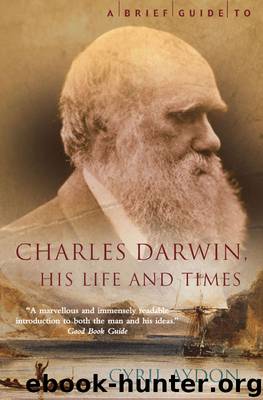A Brief Guide to Charles Darwin by Cyril Aydon

Author:Cyril Aydon
Language: eng
Format: epub
ISBN: 9781472107534
Publisher: Constable & Robinson
11
FORCED INTO THE OPEN
Three weeks after Annie’s death, Emma gave birth to a son, who was christened Horace. She had hoped that caring for a new-born child might take away some of the pain; but if anything, it was made worse by the thought that Annie was not there to take pleasure in the new baby’s arrival. In the same way that Darwin had written his note, in an attempt to preserve something of Annie’s memory while it was still fresh, she too reached out for some link with their lost child. She gathered together a few small keepsakes and a lock of Annie’s hair and placed them in a box which she would keep until she died.
For both of them, the pain of Annie’s loss was overwhelming, and their need to share it was real. But their reaction to their loss was different, and the difference made talking difficult. For her, it was a bitter test of her faith; but that faith still provided consolation. Her beloved daughter had been taken from her, but her religion told her that they would one day be reunited. For him, no such prospect was conceivable, and Annie’s death was a demonstration of the cruel and capricious chance that governed the life of every living creature.
But if he had no religion to provide consolation, he had his work to provide distraction. He immersed himself in his study of barnacles and, by the end of the year, he had two thick volumes – one on fossil barnacles, and one on living species – ready for publication. During the next three years, he produced two follow-up volumes. On 9 September 1854 he recorded in his journal the completion of his monumental task: ‘Finished packing up all my Cirripedes . . . distributing copies of my work, &c . . . Began Oct 1, 1846. On Oct 1 it will be 8 years since I began! But then I have lost 1 or 2 years by illness.’
The major part of his working day, for eight years, had been devoted to the minute examination and classification of a single group of marine crustaceans. He had studied, and described, 10,000 different varieties. It was an undertaking of which the very thought would have been enough to make most zoologists’ brains hurt. For a non-scientist, both the activity itself, and its point, was beyond comprehension. He even had doubts about it himself: ‘my work was of considerable use to me when I had to discuss . . . the principles of a natural classification. Nevertheless, I doubt whether the work was worth the consumption of so much time.’
But his scientific peers entertained no such doubts. His volumes on barnacles were universally acclaimed. Those who were best qualified to judge were the most fulsome in their praise. Even before the work was fully published, it had gained him the Royal Society’s Royal Medal. And most important of all, those eight years of painstaking work had fulfilled the purpose for which they had been embarked upon.
Download
This site does not store any files on its server. We only index and link to content provided by other sites. Please contact the content providers to delete copyright contents if any and email us, we'll remove relevant links or contents immediately.
Hit Refresh by Satya Nadella(8347)
When Breath Becomes Air by Paul Kalanithi(7280)
The Girl Without a Voice by Casey Watson(7274)
Do No Harm Stories of Life, Death and Brain Surgery by Henry Marsh(6345)
A Court of Wings and Ruin by Sarah J. Maas(6124)
Hunger by Roxane Gay(4238)
Shoe Dog by Phil Knight(4189)
Everything Happens for a Reason by Kate Bowler(4076)
A Higher Loyalty: Truth, Lies, and Leadership by James Comey(4045)
The Rules Do Not Apply by Ariel Levy(3920)
Tuesdays with Morrie by Mitch Albom(3847)
The Immortal Life of Henrietta Lacks by Rebecca Skloot(3835)
How to Change Your Mind by Michael Pollan(3693)
Millionaire: The Philanderer, Gambler, and Duelist Who Invented Modern Finance by Janet Gleeson(3577)
All Creatures Great and Small by James Herriot(3531)
Elon Musk by Ashlee Vance(3464)
Tokyo Vice: An American Reporter on the Police Beat in Japan by Jake Adelstein(3450)
Man and His Symbols by Carl Gustav Jung(3333)
The Money Culture by Michael Lewis(3296)
